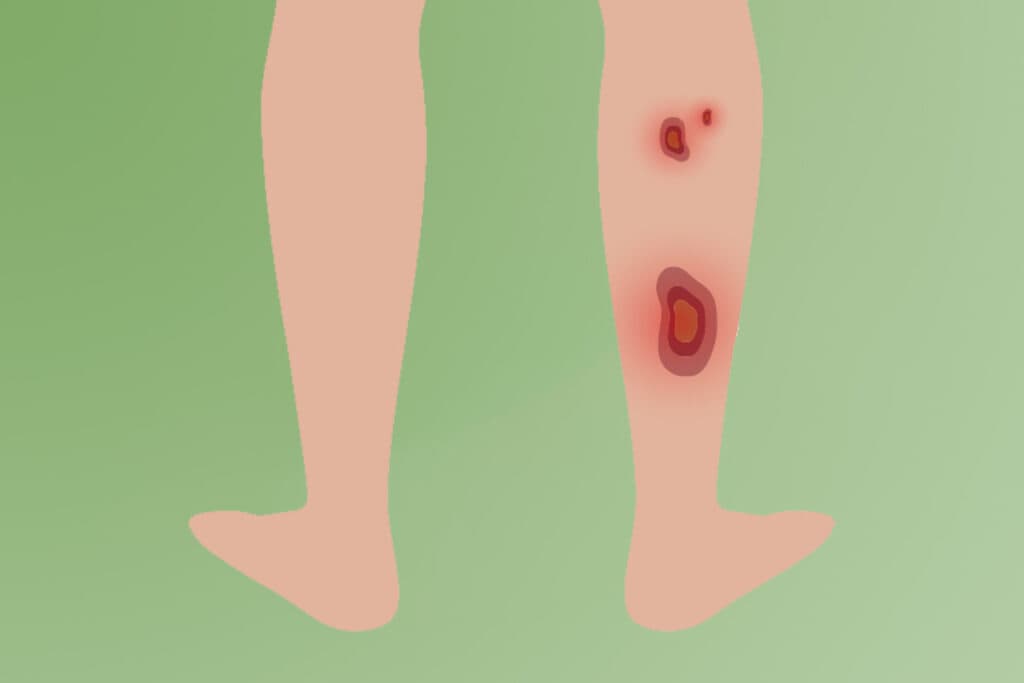Also known as: venous ulcerations, venous ulcers, venous stasis ulcers, leg ulcers, postphlebitic ulcer.
Skin ulcers are open wounds that develop on the skin, typically on the lower legs or ankles. These ulcers are often caused by underlying venous insufficiency, which leads to poor circulation and increased pressure in the veins of the legs.
Skin ulcers can worsen over time if left untreated, leading to complications such as infection, cellulitis, or even gangrene in severe cases. Proper management and treatment can help promote healing and prevent recurrence. However, healing can be slow and may require ongoing care and monitoring.

Lifestyle changes, such as maintaining a healthy weight, elevating the legs when possible, and avoiding prolonged periods of standing or sitting, can help prevent skin ulcers from recurring.
Endovenous laser therapy, also known as endovenous laser ablation, is an outpatient procedure that uses heat from a laser to reduce varicose veins and other common vein problems. After identifying the source of vein damage via ultrasound, a thin laser beam is used to cauterize and close the offending vein. This procedure is performed through a simple needle puncture under local anesthesia and takes roughly 20-45 minutes.
Radiofrequency ablation (RFA) offers a revolutionary and minimally invasive approach to treating significant varicose veins, replacing the need for stripping and removal procedures. This outpatient treatment utilizes heat to close off dysfunctional veins. A thin, flexible catheter is inserted into the targeted vein under ultrasound guidance for precise placement. Radiofrequency energy is then delivered through the catheter, gently heating the vein wall with the help of cool saline and lidocaine solution for comfort, causing the vein to close. The entire procedure typically takes only 10-15 minutes, and most patients can return to their daily activities as soon as the next day.
Superficial veins are often very thick and ropey in appearance, and they can grow large over the years. Additionally, the skin over these veins may have a darkened, more pigmented appearance due to chronic inflammation and the pressurized veins.
High ligation is a surgical procedure that involves tying off a damaged vein to redirect blood flow, and vein stripping refers to the removal of the damaged vein. In cases of advanced venous disease, our vascular surgeons may recommend high ligation and vein stripping as an outpatient procedure at a regional hospital. This procedure requires general anesthesia and is less commonly performed than other minimally invasive options, but it does have a high success rate and is the best option in some individual cases.
Compression stockings offer a cost-effective and efficient method to enhance blood circulation in the lower extremities. With daily use, compression stockings can alleviate symptoms, enhance blood flow, and reduce the likelihood of blood clots forming. These stockings are suitable for both short-term and long-term use, as well as post-surgery recovery.
Skin ulcer symptoms can vary depending on the type and severity, but typically include open sores that are slow to heal, pain or tenderness, swelling, and sometimes drainage or odor. Skin surrounding the ulcer may appear discolored, thickened, or inflamed. Early diagnosis is key to preventing complications.
Skin ulcer stages range from mild to severe. In the early stages, you might notice redness, irritation, or minor skin breakdown. As the condition progresses, ulcers can deepen, exposing underlying tissue or bone. Recognizing the stages helps guide appropriate treatment and healing strategies.
A venous skin ulcer typically develops due to poor circulation in the legs, often linked to chronic venous insufficiency. These ulcers are commonly found near the ankles and can be painful and slow to heal. Treatment focuses on improving blood flow with compression therapy, wound care, and, in some cases, minimally invasive vascular procedures.
A decubitus skin ulcer, also known as a pressure sore or bed sore, forms when prolonged pressure reduces blood flow to the skin. Unlike venous ulcers, these are often found on bony areas such as the hips, heels, or tailbone—especially in patients with limited mobility. Prevention includes regular repositioning and specialized mattresses.
Chattanooga | Cleveland | North Georgia | Jasper | Dayton | Hixson

Monday: 8 AM – 5 PM • Tuesday: 8 AM – 5 PM • Wednesday: 8 AM – 5 PM • Thursday: 8 AM – 5 PM • Friday: 8 AM – 5 PM • Saturday: Closed • Sunday: Closed
Monday: 8 AM – 5 PM
Tuesday: 8 AM – 5 PM
Wednesday: 8 AM – 5 PM
Thursday: 8 AM – 5 PM
Friday: 8 AM – 5 PM
Saturday: Closed
Sunday: Closed
Call now to book an appointment.
Conveniently located near Northgate Mall.